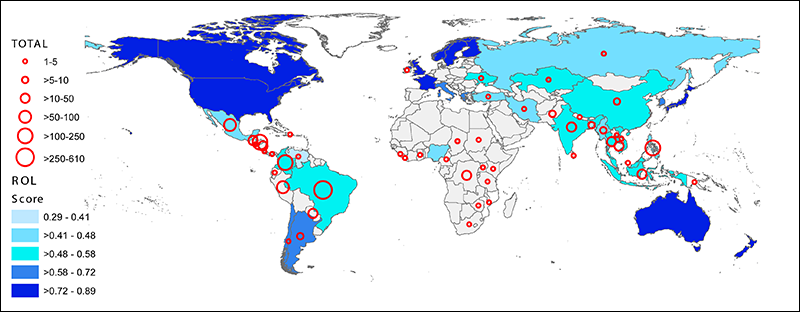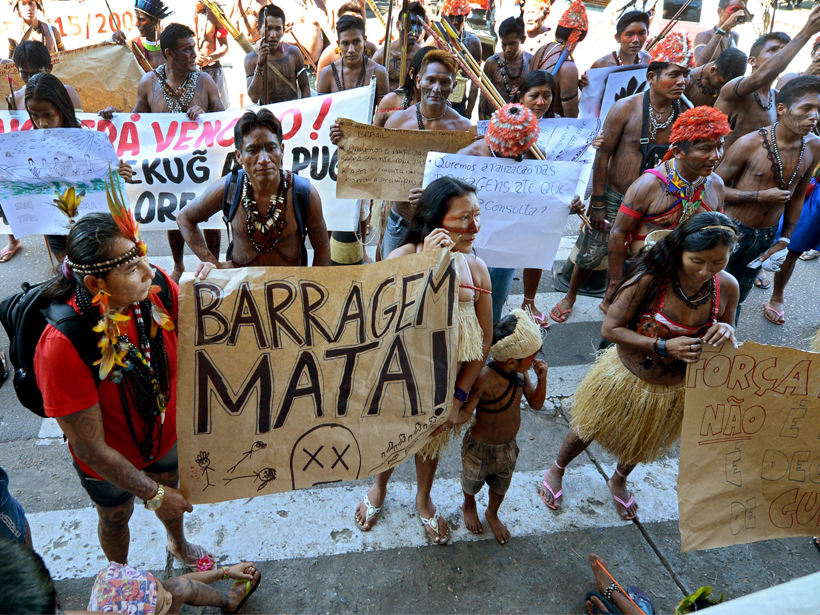Environmental activists and defenders are killed at twice the rate that they were 15 years ago, according to a new study. The researchers found that more environmental defenders were murdered in countries with a weaker rule of law and where more land area was harvested.
“As consumers in wealthy countries—who are effectively outsourcing our resource consumption—we share responsibility for what’s happening.”
“Environmental defenders help protect land, forests, water and other natural resources,” Nathalie Butt, lead author of the study, said in a statement. “They can be anyone—community activists, lawyers, journalists, members of social movements, [nongovernmental organization] staff, and indigenous people—anyone who resists violence.”
“As consumers in wealthy countries—who are effectively outsourcing our resource consumption—we share responsibility for what’s happening,” said Butt, who studies the ecological impacts of climate change at the University of Queensland in St. Lucia, Australia. “Businesses, investors, and national governments at both ends of the chain of violence need to be more accountable.”
Environmentalists Dying Around the World
The study, which was published in Nature Sustainability on 5 August, analyzes reports of environmentalists’ deaths around the world from the international environmental organization Global Witness.
The researchers found that 1,558 people in 50 countries around the world were killed defending the environment between 2002 and 2017. “This is more than double the number of United Kingdom and Australian armed service people killed on active duty in war zones over the same period…and almost half as many as the number of U.S. soldiers killed in Iraq and Afghanistan since 2001,” the study says.
More indigenous people were killed defending their land and environment than were people of any other group.
During those 15 years, the rate at which environmental activists were murdered increased from two murders per week to four per week. The death toll in Brazil, the Philippines, Colombia, and Honduras represented about 71% of all environmentalists killed during that time period.
One particularly concerning finding is that about 40% of the murders in 2015 and 2016, and about 30% of the killings in 2017, were of indigenous persons. More indigenous people were killed defending their land and environment than were people of any other group.
“This is a phenomenon seen around the world: land and environmental defenders are declared terrorists, locked up or hit with paralyzing legal attacks, for defending their rights, or simply for living on lands that are coveted by others,” stated Victoria Tauli-Corpuz, the United Nations Special Rapporteur on the rights of indigenous peoples.
Killing for Natural Resources and Getting Away with It
The researchers also gathered data from organizations that track rule of law and environment-related business sectors. They found that the mining, agribusiness, water resources, and logging sectors were tied to or suspected in the highest number of deaths. More deaths occurred in countries with higher corruption rates and a weaker rule of law.
“Corruption was the key correlate for the killings.”
What’s more, murders of environmentalists were much less likely to have legal ramifications than were other murders: Homicides had an overall conviction rate of 43% in 2012, but the conviction rate was only 10% for the killings of environmentalists.
“Although conflict over natural resources is the underlying cause of the violence, spatial analyses showed corruption was the key correlate for the killings,” Butt said. “In many instances, weak rule of law means that cases in many countries are not properly investigated, and sometimes it’s the police or the authorities themselves that are responsible for the violence.”

Criminalizing Environmental Activism
Global Witness released its 2018 report on attacks against environmental defenders on 30 July. The organization found that 164 people were killed last year, an average rate of more than three per week.
“Countless more were silenced through other tactics designed to crush protest, such as arrests, death threats, lawsuits and smear campaigns,” the agency stated.

Mining and agribusiness remained the first- and second-deadliest sectors for environmentalists, but last year also saw a spike in the number of deaths related to water resources. The 2018 report was released days before unrelated reports from the World Resources Institute on global water stress and from the Intergovernmental Panel on Climate Change on vulnerabilities in the land and food sectors.
Last year, Global Witness also tracked a rise in the criminalization of activism, including in the United Kingdom and Iran, a trend that the agency says has continued so far in 2019. The organization specifically called out Brazilian president Jair Bolsonaro and U.S. president Donald Trump for agendas that promote business over the environment and for policies that strip away environmental and human rights protections.
“It is a brutal irony that while judicial systems routinely allow the killers of defenders to walk free, they are also being used to brand the activists themselves as terrorists, spies or dangerous criminals,” Alice Harrison, a senior campaigner at Global Witness, said in the statement accompanying the report. “Both tactics send a clear message to other activists: the stakes for defending their rights are punishingly high for them, their families and their communities.”
—Kimberly M. S. Cartier (@AstroKimCartier), Staff Writer
10 August 2019: A figure was removed from this article.
12 August 2019: A figure was inserted into this article.
Citation:
Cartier, K. M. S. (2019), Murders of environmentalists have doubled in 15 years, Eos, 100, https://doi.org/10.1029/2019EO130897. Published on 09 August 2019.
Text © 2019. AGU. CC BY-NC-ND 3.0
Except where otherwise noted, images are subject to copyright. Any reuse without express permission from the copyright owner is prohibited.
Text © 2019. AGU. CC BY-NC-ND 3.0
Except where otherwise noted, images are subject to copyright. Any reuse without express permission from the copyright owner is prohibited.

